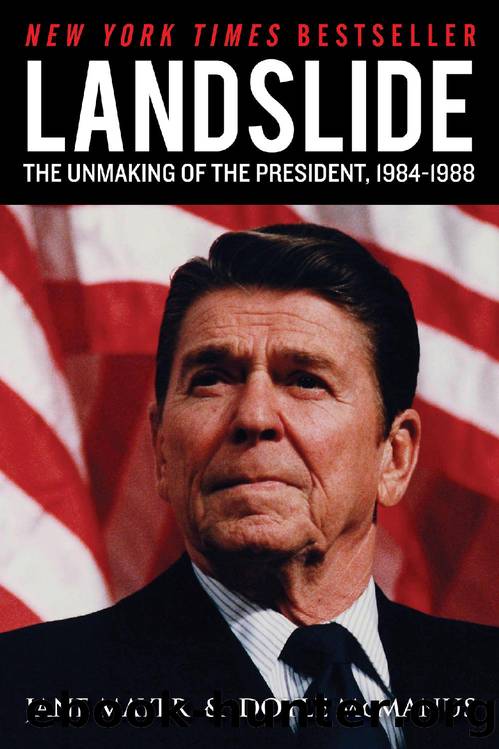Landslide: The Unmaking of the President, 1984-1988 by Jane Mayer & Doyle McManus

Author:Jane Mayer & Doyle McManus [Mayer, Jane & McManus, Doyle]
Language: eng
Format: epub
Publisher: Graymalkin Media, LLC
Published: 2018-09-24T00:00:00+00:00
11
Into Tehran
TEHRAN HAS ALWAYS BEEN an unlovely city. It spills chaotically down a sloping plain in a vast brown jumble, the invention of twentieth-century kings who turned their backs on Persian tradition to ape the industrial centers of the West. Automobiles choke its dusty streets, and a pall of smog often obscures the only relief on the landscape, the long, sere shoulder of the Elburz Mountains rising from the cityâs northern suburbs. The minarets of Tehranâs mosques are outnumbered by the rusting spikes of paralyzed construction cranes, relics of a dynasty that ran out of money, time, and fear. Instead, the cityâs new landmarks are a grisly fountain of blood, which spouts crimson dye in praise of Muslim martyrs, and ubiquitous posters of Ayatollah Ruhollah Khomeini, the revolutionary who made Tehran the capital of âthe worldâs first government of Godââand, to some, the capital of world terrorism as well.
Into that unwelcoming landscape on Sunday morning, May 25, flew Bud McFarlane and Oliver North. They bore false Irish passports, a brace of gift-wrapped .357 pistols, a chocolate layer cake decorated with a brass keyâand suicide pills in case the gifts were ill received. As their unmarked Israeli 707 approached Tehranâs Mehrabad International Airport, McFarlane and North believed they might be on the verge of a diplomatic master stroke. For seven years the United States and Iran had been bitterly estranged; there had been almost no communication between Washington and the most powerful government on the strategically important Persian Gulf. In McFarlaneâs mind, at least, this mission to Tehran had more ambitious goals than winning the release of American hostages in Beirut. If the Iranians agreed to even a modest cooperative relationship with the United States, the Reagan administration could virtually redraw the political map of the Middle East. An Iranian-American entente would be a major vexation for the Soviet Union, which was already worried about Iranâs support for Muslim rebels in neighboring Afghanistan.
There had been months of preparation. The airplane carried HAWK missile spare parts, secure communications equipment, maps for an eight-hour intelligence briefing for the Iranians, and an outline of the terms of a new U.S.-Iranian relationship. The HAWK parts were lashed to a pallet behind the passenger seats. âYou had to trip over it to go to the head,â Oliver North noted. Eleven more palletsâalso loaded with missile partsâwere on a second plane under Richard Secordâs command, waiting on the ground in Israel. None of the parts was to be released until the hostages were freed.
The delegation itself was ready for serious negotiations. In addition to McFarlane and North, as personal envoys of the president of the United States, the plane carried Howard Teicher, the NSCâs senior director of political-military affairs; George Cave of the CIA, who spoke fluent Persian and who grew a mustache to disguise himself for the mission; a CIA radioman, who set up a temporary coded satellite link to Washington; and, riskiest of all, Israelâs Amiram Nir, posing as an American because of the Iraniansâ hatred of the Jewish state.
Download
This site does not store any files on its server. We only index and link to content provided by other sites. Please contact the content providers to delete copyright contents if any and email us, we'll remove relevant links or contents immediately.
The Secret History by Donna Tartt(16657)
The Social Justice Warrior Handbook by Lisa De Pasquale(11493)
Thirteen Reasons Why by Jay Asher(7801)
This Is How You Lose Her by Junot Diaz(5797)
Weapons of Math Destruction by Cathy O'Neil(5046)
Zero to One by Peter Thiel(4834)
The Myth of the Strong Leader by Archie Brown(4795)
Promise Me, Dad by Joe Biden(4455)
Beartown by Fredrik Backman(4433)
Stone's Rules by Roger Stone(4422)
How Democracies Die by Steven Levitsky & Daniel Ziblatt(4413)
The Fire Next Time by James Baldwin(4350)
100 Deadly Skills by Clint Emerson(4085)
A Higher Loyalty: Truth, Lies, and Leadership by James Comey(4039)
Rise and Kill First by Ronen Bergman(4020)
The David Icke Guide to the Global Conspiracy (and how to end it) by David Icke(3891)
The Farm by Tom Rob Smith(3878)
Secrecy World by Jake Bernstein(3788)
The Doomsday Machine by Daniel Ellsberg(3737)
